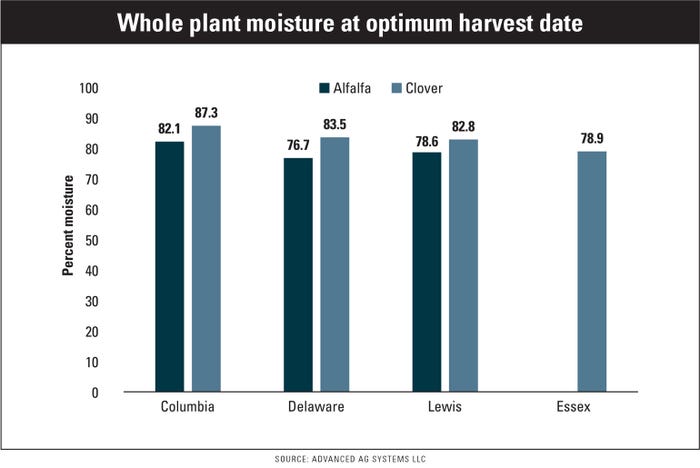June 23, 2020

Based on past research supported by the New York Farm Viability Institute as well as more detailed research in 2019, a clear alternative is emerging for poorly drained soils: red clover using modern management techniques.
Let’s start with the major objection to red clover: It is wet and doesn’t dry.
Yes, it was 5.4% wetter than paired alfalfa in our replicated trials in three locations. In 2011, the research showed that under adverse drying conditions — all three sites had significant rain the night before and it was the second-year, heavy first-cutting clover, which is typically 30% higher yielding than the same alfalfa — all sites achieved over 30% dry matter the same day mowed.
The key was to mow at greater than 80% of cutter bar with no deflector shields of any type. After two hours of drying, a careful tedding lifted the bottom layers and brought them up to the top to dry. There was no response to conditioning and there was no need to run the tedder on the second and third cut.
Last year our research showed that the red clover — both at the same harvest date as the alfalfa and at the 40 NDF harvest dates for each — out-yielded the alfalfa in the first harvest. In two sites the alfalfa did not establish or established poorly in the spring seedings. The first cut of clover at 40 NDF (neutral detergent fiber) harvest date was an average 33% higher yielding than the paired alfalfa at its 40 NDF harvest date.
At the Columbia, N.Y., site, the clover was 35% higher yielding than alfalfa; at the Delaware, N.Y., site it was 31% higher yielding than alfalfa. At the Columbia site the alfalfa lost yield as harvest went past optimum. The majority of this was a loss of lower leaves and petioles. Clover also lost yield but at a slightly later time frame.
Delaying harvest past optimum at both sites resulted in severe lodging in both the clover and alfalfa.
The average clover yield at 40 NDF harvest date for all four sites was 3.19 tons of dry matter. The important point is that this was only the first cut; we still had two more harvests to add to the tonnage.
Clover in a short rotation has the potential to increase the production on our less-than-ideal drained soils.
Compaction limits results
Farmers may object that clover will not yield when it turns dry compared to alfalfa. But is this the result of the crop or the soils in which the crop is planted?
Compaction might be the answer.
Alfalfa is grown on well-drained soils, which usually means deep rooting potential. Clover is grown on poorer-drained soils.
Nearly all the poorer draining soils I have looked at over the years were plowed when it was too wet.
Compaction doesn’t go away magically; it will last for decades until it is removed.

One example of this was our research that found a yield-limiting plow pan in an alfalfa-timothy sod that had been established for 15 years. There were no roots below 6 inches. Compaction on these moderate to wetter soils limits the root growth and water availability of the clover to 6 or 7 inches, severely limiting yield when it turns dry.
We deep-tilled severely compacted sand and gravel on 30-inch centers when it was in corn. A year after seeding clover it turned very dry. The alfalfa and clover turned brown and died back. When it rained again the clover came up and grew fine in foot-wide strips on 30-inch centers where the compacted pan was eliminated.
Removing compaction takes planning and fore thought.
Less cuttings, hairy leaves
Research from University of Wisconsin shows that, depending on how far north you are, three or four cuttings of clover are all that’s needed to maximize yield and quality. Compared to five or six cuttings of alfalfa, this is a substantial reduction in harvest time, cost per ton of dry matter and weather risk. It opens the potential to put profit back into your high-forage diet.
Red clover also has naturally hairy leaves. This will repel potato leafhoppers, eliminating the expense and need to spray for it. My experience with the hairless type was that hoppers loved it and killed the stand. Our research shows that you don’t need the hairless type to dry for same-day haylage.

Last year’s research found that the perception of red clover not supporting milk production is not true. Poor management, based on farming practices from decades ago, will destroy most of the potential for red clover to profitably sustain high milk production
Using clover, we can potentially increase the digestibility of legume forage harvested on heavier soils to the digestibility levels of the new alfalfa varieties that will not survive there.
Kilcer is a certified crop adviser in Kinderhook, N.Y.
About the Author(s)
You May Also Like




